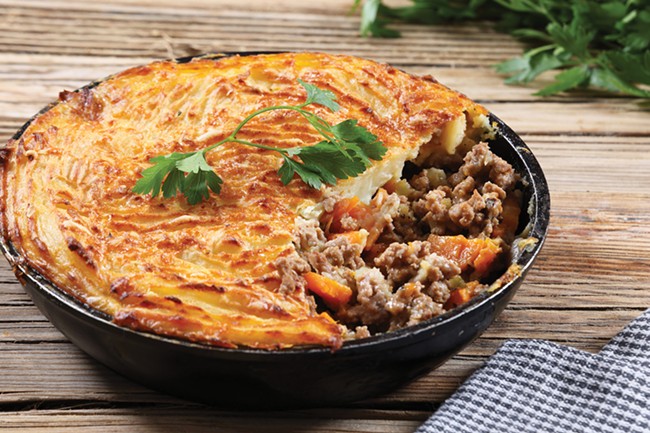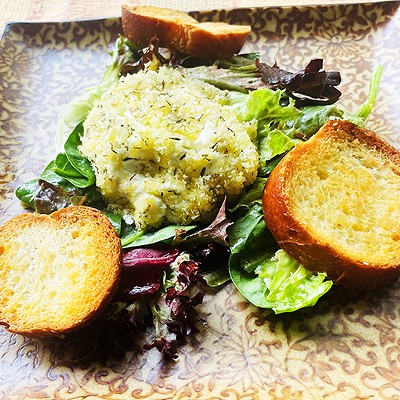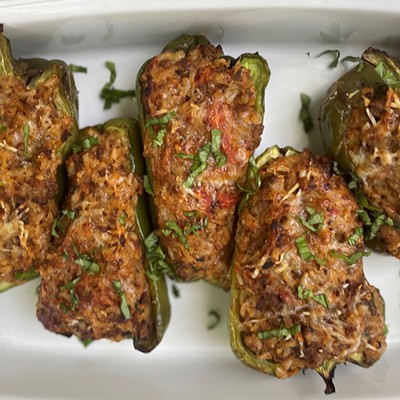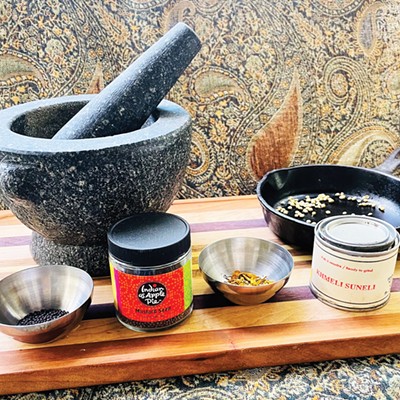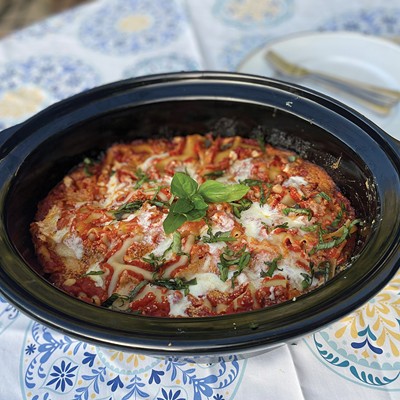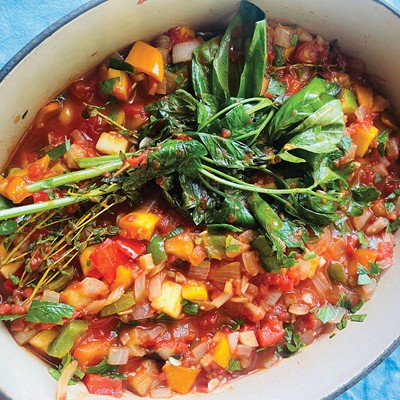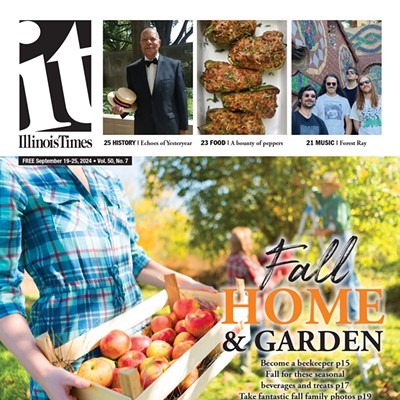Shepherd's pie is classic stick-to-your ribs pub fare. Its origins can be traced back to the pastry-topped Scottish meat pies, with the Irish supposedly swapping creamy mashed potatoes for the dough. One important, if slightly nerdy clarification, is that it's not really a shepherd's pie unless it is made with lamb. When made with beef or pork the dish is called a cottage pie, and it sometimes features a sliced potato topping as opposed to mashed. An infinitely variable recipe, the version I had most often growing up was actually made with the remnants of a roast lamb dinner. Cubes of garlic-and-rosemary-flecked lamb would be mixed with the leftover gravy and topped with day-old mashed potatoes for an efficient feast that was just as delicious as the original meal.
Shepherd's pie can easily be made gluten-free by substituting cornstarch for the flour and using broth instead of beer. A vegetarian version, which I like to call a gardener's pie, makes good use of protein-rich cannellini beans and savory vegetable broth. Just substitute a tablespoon of olive oil or butter for the bacon, then skip the meat and add the mushrooms to the pan straightaway. Add a can of drained beans along with a bag of frozen chopped spinach to the filling mixture for a satisfying and nutritionally complete vegetarian meal.
This recipe is easily doubled, so feel free to make an extra casserole to stash in the freezer. While still a hearty feed, my recipe for shepherd's pie has been lightened with the addition of cauliflower and mushrooms to the topping and filling. A crisp apple-and-arugula salad is a lovely complement to this dish's savory richness.
Shepherd's pie
1 ½ pounds potatoes, peeled and cut into cubes
2 cloves garlic
1 pound cauliflower florets
¼ cup butter
½ cup whole milk
1 egg
1 cup grated aged cheddar, plus more for top
2 slices bacon, chopped
1 pound ground lamb (or use roughly 2 cups diced leftover roast lamb)
1 1/4 teaspoons salt, divided
1 pound button mushrooms, chopped
2 onions, diced
2 carrots, diced
3 stalks celery, diced
4-5 cloves garlic, minced
2 tablespoons flour
3 tablespoons tomato paste
½ teaspoon dried thyme
1 12-ounce bottle stout beer such as Guinness
½ cup frozen peas
½ cup chopped parsley
Place the potatoes and garlic in a pot of heavily salted cold water and place on the stove over high heat. Bring to a boil, then add the cauliflower florets. Cook for an additional 8-10 minutes or until the vegetables can be easily pierced with a knife. Drain, add the butter and whole milk and mash. Let the mixture cool for about 10 minutes before thoroughly mixing in the beaten egg and cheese. Set aside.
While the potatoes are cooking, start on the lamb mixture. Place a large skillet over medium-high heat. When hot (Test this by sprinkling some water in the skillet. If the water sizzles the pan is ready.) add the bacon. Cook the bacon until the fat has mostly rendered out and it is beginning to get crispy. Add the lamb and sprinkle it with about ½ teaspoon of the salt. Cook, breaking the lamb up into small crumbles with a wooden spoon, until well browned. Transfer the browned lamb to a bowl and set aside. Return the skillet to the heat and add the mushrooms and a pinch of the salt. Cook, stirring frequently until the liquid has evaporated and the mushrooms are brown. Add the onions, celery, carrots and garlic and another pinch of the salt and cook until the vegetables have softened and are just beginning to brown. Add the meat back into the pan and mix in the flour. Add the tomato paste, thyme and beer and stir well to incorporate. Bring the mixture to a bubbly simmer, stirring all the while, then reduce heat and cook for a further five minutes. Remove from heat, then stir in the peas and parsley.
Thoroughly butter a deep-sided 9-inch by 13-inch baking dish (or you can just bake it right in the skillet). Transfer the lamb to the buttered dish and spread into an even layer. Top with the mashed potatoes, spreading them into an even layer with a spatula. Top with additional grated cheese if desired and cover with a piece of buttered foil. At this point the casserole can be refrigerated for 3-4 days or frozen for about a month.
When ready to bake, preheat the oven to 350 degrees. Place the casserole on a foil-lined baking sheet to catch any drips, then place in the preheated oven and bake for 35 minutes for a room-temperature casserole, or about an hour for a frozen casserole. Remove the foil and bake for a final 15 minutes before removing from the oven. The internal temperature of the casserole should read 160 degrees on a meat thermometer. Let rest for 15 minutes before serving.

